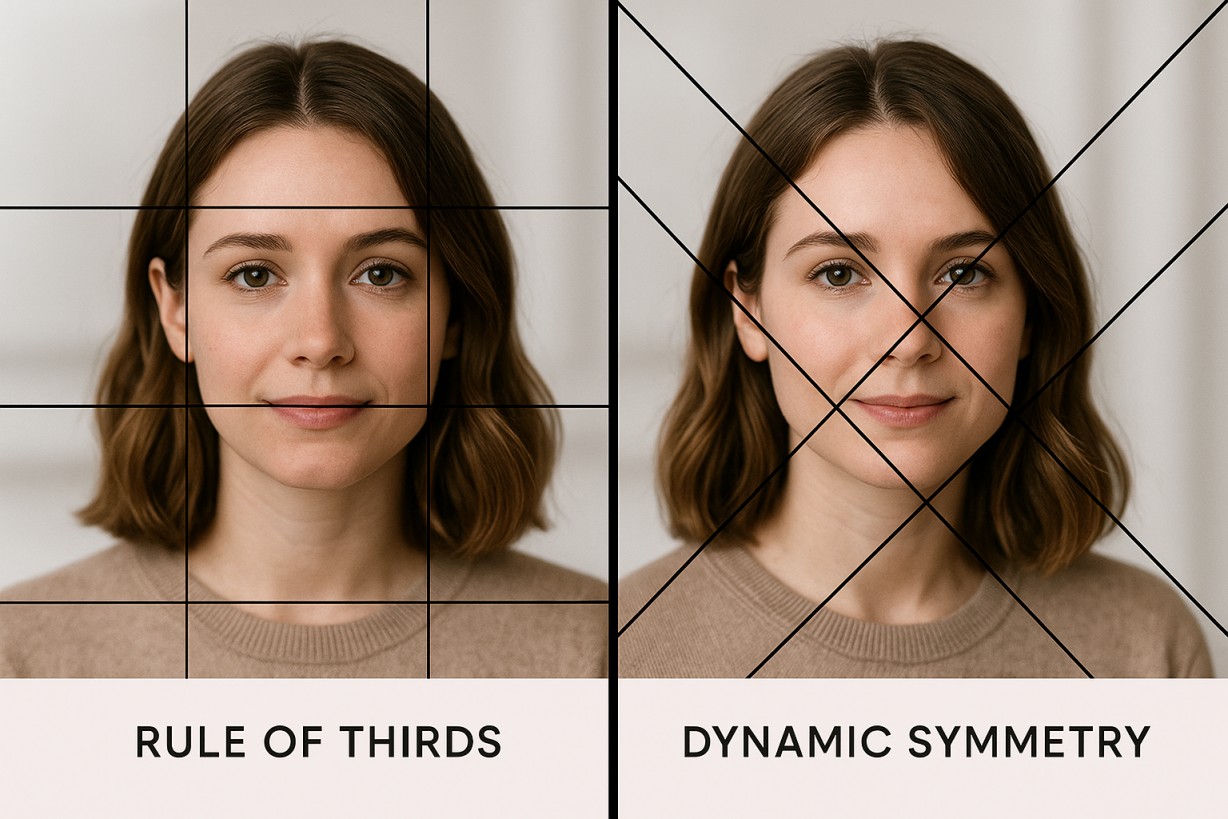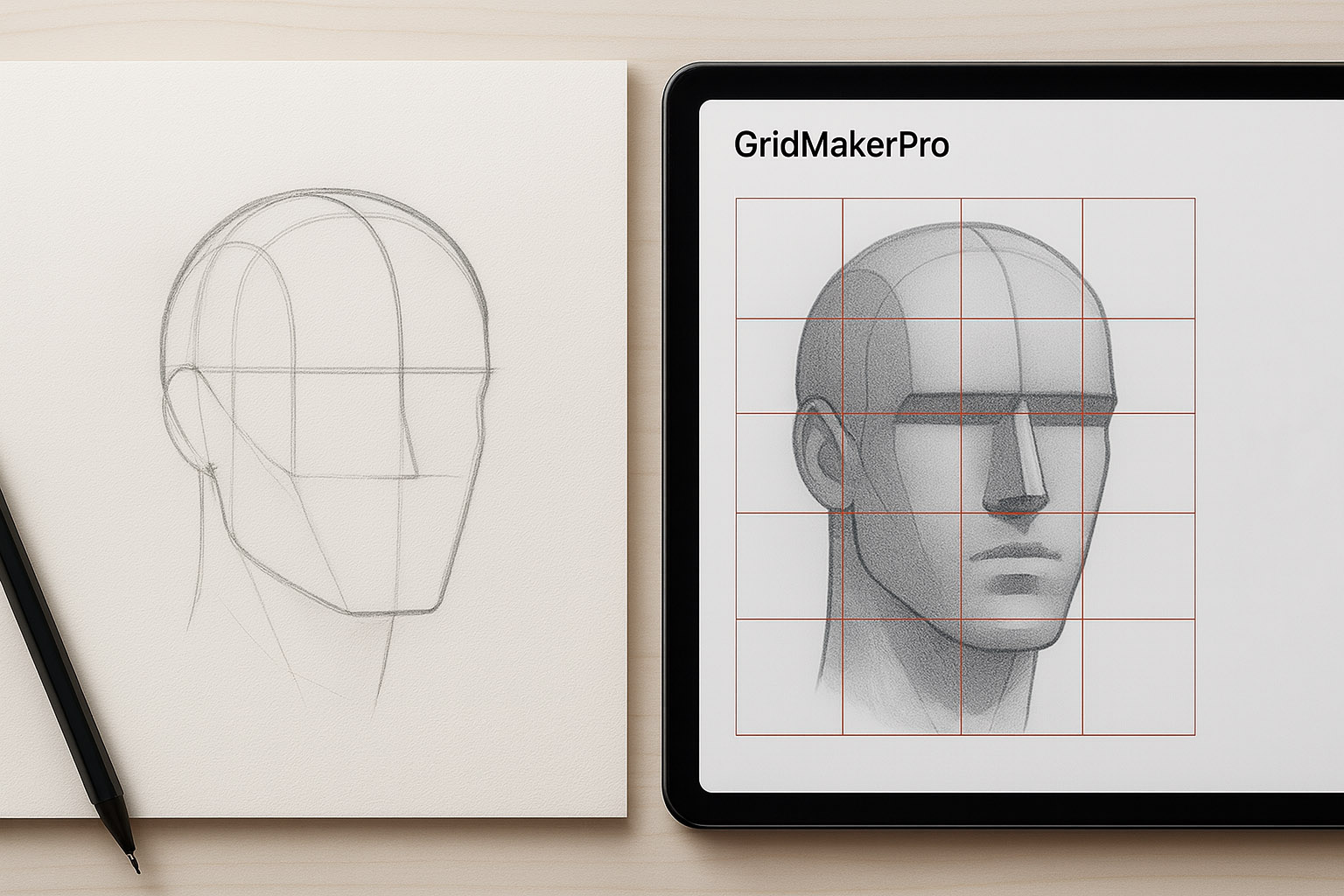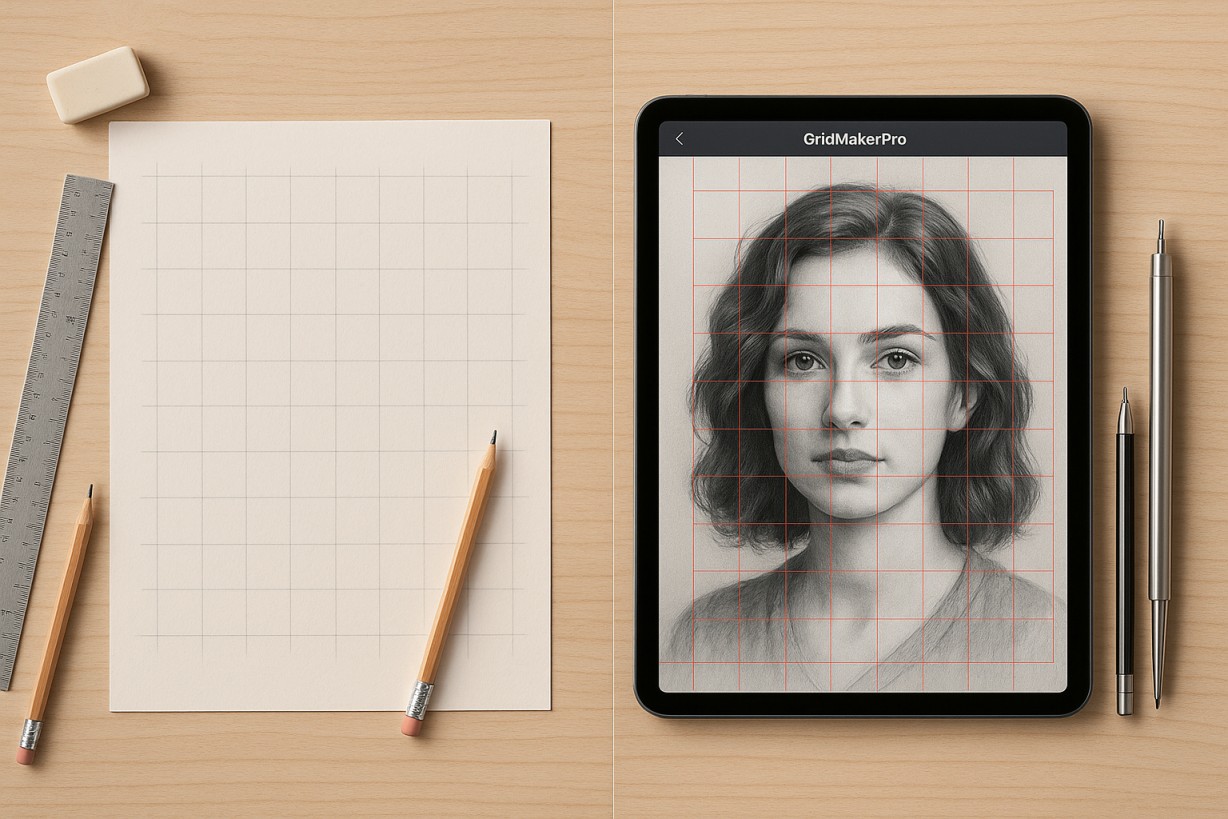Composition can make or break your artwork. You might have perfect technique, accurate proportions, and beautiful rendering, but without strong composition, your piece won’t capture and hold the viewer’s attention. Two of the most powerful compositional tools available to artists are the Rule of Thirds and Dynamic Symmetry—but which one should you use?
The answer isn’t straightforward, and that’s what makes it interesting. Let’s explore both approaches, understand when to use each, and discover how GridMakerPro can help you master both systems.
The Rule of Thirds: accessible and effective
What is it?

The Rule of Thirds is perhaps the most widely known compositional guideline. It divides your canvas into nine equal parts using two equally spaced horizontal lines and two equally spaced vertical lines, creating a 3×3 grid.
The principle is simple: place your important compositional elements along these lines or at their intersections (called “power points”). This creates more dynamic, visually interesting compositions than simply centering your subject.
Why it works
The Rule of Thirds works for several psychological and visual reasons:
Avoids static composition: Centered subjects can feel boring or passport-photo-like. Offset placement creates tension and interest.
Creates visual movement: Elements placed off-center encourage the eye to travel through the composition.
Balances negative space: When your subject occupies one-third of the frame, the remaining two-thirds provide breathing room and context.
Intuitive application: The simplicity of the Rule of Thirds makes it accessible to beginners while remaining useful for professionals.
When to use the Rule of Thirds
The Rule of Thirds excels in:
Photography and digital art: Quick, intuitive composition decisions that work reliably across various subjects.
Landscape composition: Placing the horizon along the upper or lower third line creates either an earth-dominant or sky-dominant composition.

Portrait positioning: Placing eyes along the upper third line and positioning the subject in the left or right third creates engaging portraits.
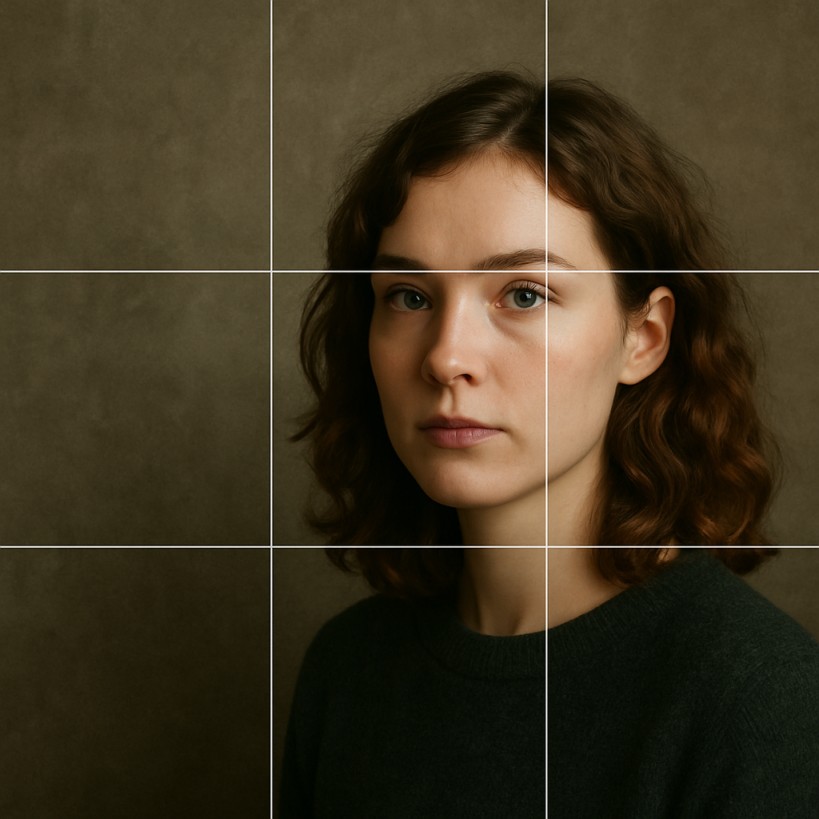
Asymmetrical subjects: When you have a clear focal point that you want to emphasize through placement.
Quick sketches and studies: When you need a reliable compositional framework without extensive planning.
Limitations of the Rule of Thirds
While powerful, the Rule of Thirds has constraints:
Not ratio-specific: The 3×3 grid doesn’t account for your canvas’s actual proportions or the natural geometry within your subject.
Can feel formulaic: Overuse can lead to predictable, similar-looking compositions.
Doesn’t address internal relationships: It helps you place major elements but doesn’t guide the relationships between all parts of your composition.
Limited classical foundation: It’s a simplified modern interpretation rather than based on classical artistic principles.
Dynamic Symmetry: the classical powerhouse
What is it?
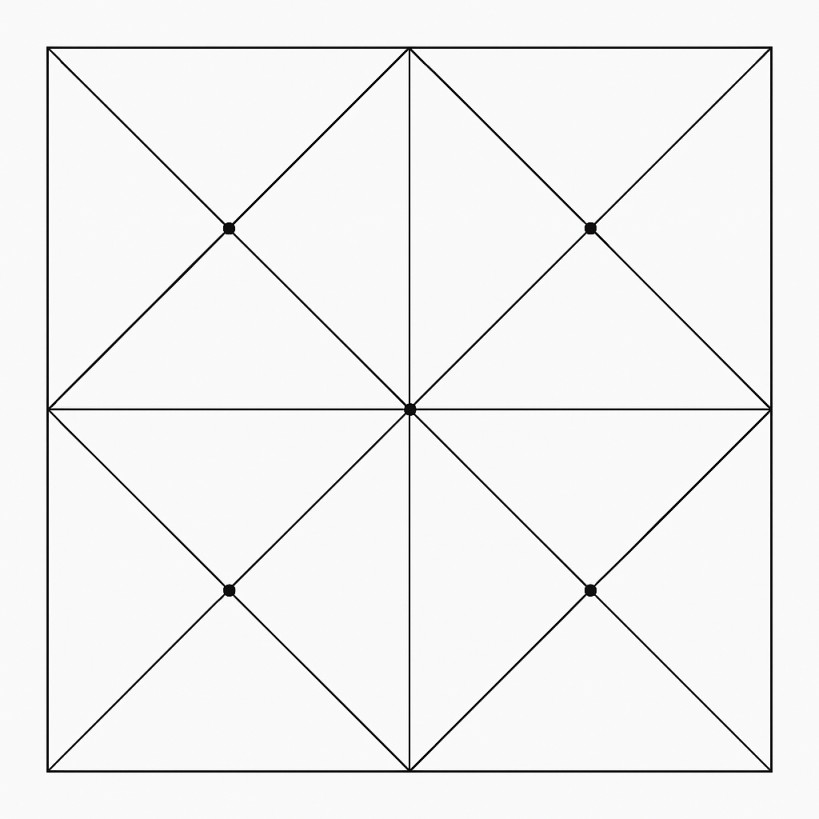
Dynamic Symmetry is a sophisticated compositional system based on geometric principles used by classical artists. Unlike the Rule of Thirds’ simple 3×3 grid, Dynamic Symmetry uses diagonal lines, root rectangles (√2, √3, √4, √5, etc.), and reciprocal divisions based on your canvas’s actual proportions.
The most common Dynamic Symmetry grids include:
- Diagonal lines from corner to corner
- Reciprocal diagonals (perpendicular to the main diagonals)
- Horizontal and vertical lines where these diagonals intersect
- “Baroque diagonals” and “Sinister diagonals”
Why it works
Dynamic Symmetry is rooted in mathematics and human perception:
Based on canvas proportions: The grid is generated from your actual canvas ratio, creating harmony between format and composition.
Mathematical harmony: Uses ratios like the Golden Ratio (1:1.618) and root rectangles that are inherently pleasing to the human eye.
Classical foundation: This system (or similar approaches) was used by masters like Vermeer, Rembrandt, and the ancient Greeks.
Creates visual flow: The diagonal emphasis naturally leads the eye through the composition in dynamic movements.
Hierarchical structure: Creates major and minor areas of interest with clear relationships between them.
When to use Dynamic Symmetry
Dynamic Symmetry shines in:
Classical figure painting: When composing complex figure arrangements where multiple elements need to relate harmoniously.
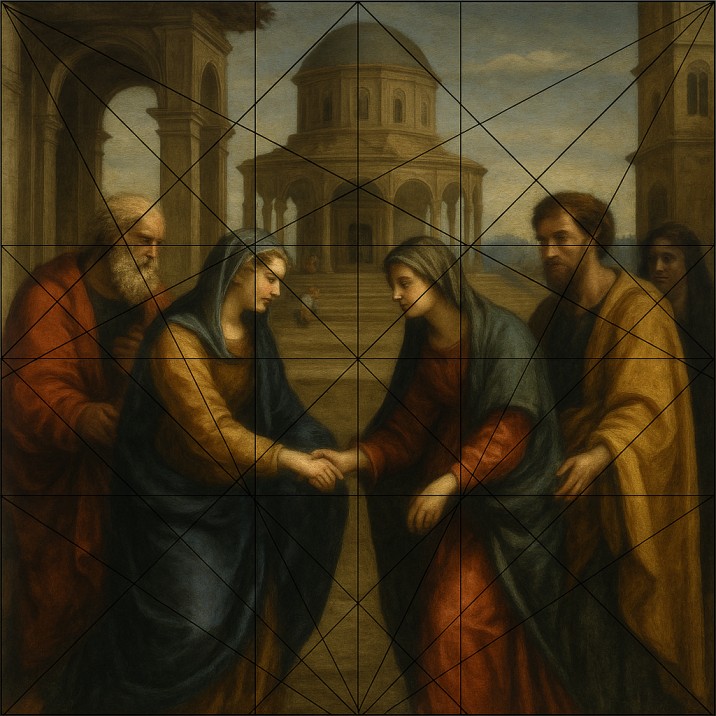
Complex compositions: Multiple subjects, layers of depth, or intricate scenes benefit from the sophisticated organizational structure.
When canvas ratio matters: You’re working with a specific classical ratio (like 1:1.618 or 1:1.5) and want composition that exploits that format.
Fine art and gallery work: Pieces intended for serious artistic consideration benefit from the classical rigor.
Deliberate, planned compositions: When you have time to carefully consider and construct your composition.
Learning from masters: When studying or recreating classical compositions to understand how the masters achieved their results.
The learning curve
Dynamic Symmetry is significantly more complex than the Rule of Thirds:
Requires study: You need to understand the geometric principles and how to construct these grids.
More planning intensive: Using Dynamic Symmetry effectively requires forethought and often multiple compositional sketches.
Canvas-specific: Different canvas ratios generate different grids, so there’s no one-size-fits-all approach.
Can be overwhelming: The complexity might paralyze decision-making rather than facilitate it, especially for beginners.
Direct comparison: same subject, different grids
Let’s imagine composing a portrait to see how each system guides your decisions:
Rule of Thirds approach:
- Place the subject’s eyes along the upper horizontal third line
- Position the subject in the left or right vertical third
- Use the remaining two-thirds for negative space or environmental context
- Place secondary elements (like hands or props) near the other power points
Result: A clean, accessible composition with clear focal point and good balance.
Dynamic Symmetry approach:
- Align the subject’s main vertical axis with a reciprocal diagonal
- Position the eyes where a horizontal crosses a major diagonal
- Arrange the torso angle to follow or contrast with the canvas diagonals
- Place hands, props, or compositional elements at diagonal intersections
- Create depth by having background elements follow different diagonals
Result: A more sophisticated, harmonious composition with complex internal relationships and classical elegance.
Hybrid approaches: the best of both worlds
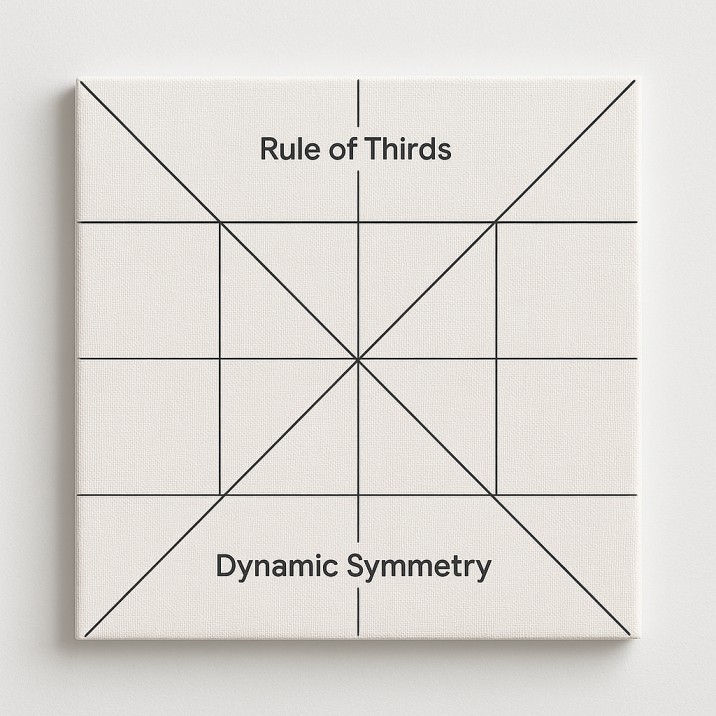
Many contemporary artists don’t choose one system exclusively:
Start with Rule of Thirds, refine with Dynamic Symmetry: Use the Rule of Thirds for initial placement, then use Dynamic Symmetry to finalize relationships and details.
Dynamic Symmetry for planning, intuition for execution: Construct your composition using Dynamic Symmetry, but draw freely once you’ve internalized the structure.
Alternate based on project: Use Rule of Thirds for commercial, quick-turnaround work, and Dynamic Symmetry for personal fine art.
Simplified Dynamic Symmetry: Use only the main diagonals and reciprocals from Dynamic Symmetry without the full complexity—a middle ground between the two systems.
Practical considerations
Time and workflow
Rule of Thirds: Seconds to implement, perfect for fast-paced work or when making many compositional decisions quickly.
Dynamic Symmetry: Minutes to construct the grid properly, best for deliberate, planned compositions where you can afford to invest time upfront.
Project goals
Ask yourself:
What’s the end use? Social media and commercial work often benefits from the punch and accessibility of Rule of Thirds. Gallery work and fine art pieces reward Dynamic Symmetry’s sophistication.
Who’s your audience? General viewers respond to both, but art-educated audiences may appreciate classical structure more.
What’s your timeline? Rush projects demand Rule of Thirds efficiency. Personal projects allow Dynamic Symmetry exploration.
Your skill level
Beginners: Start with Rule of Thirds. Master it completely before adding Dynamic Symmetry complexity. You need to walk before you run.
Intermediate artists: Begin exploring Dynamic Symmetry while continuing to use Rule of Thirds as your default. Compare results.
Advanced artists: Develop fluency with both systems. Choose consciously based on the specific needs of each piece. Eventually internalize both approaches and compose intuitively.
Using GridMakerPro to master both systems
GridMakerPro makes it easy to experiment with and compare both compositional approaches:
Quick comparison: Apply both a Rule of Thirds grid and a Dynamic Symmetry grid to the same reference photo. See immediately how each system suggests different placements.
Learning tool: Study master paintings with both grid types overlaid. Discover which system (or combination) they used.
Compositional sketching: Before committing to a final piece, try multiple compositions with different grid systems to see which serves your vision best.
Custom configurations: Create variations—perhaps a Rule of Thirds grid but with additional Dynamic Symmetry diagonals for extra guidance.
Practical exercises
Exercise 1: Same subject, both grids
Take a single reference photo. Compose a piece using Rule of Thirds guidelines, then compose the same subject using Dynamic Symmetry. Compare the results. Which feels stronger? Why?
Exercise 2: Master study
Find a classical painting you admire. Apply both grid types. Which system does the composition seem to follow? Many classical works use Dynamic Symmetry, but some follow intuitive divisions similar to Rule of Thirds.
Exercise 3: Portfolio analysis
Look at your recent work. Which grid system does your natural, intuitive composition tend to follow? This reveals your compositional instincts and shows you where to expand.
Exercise 4: Intentional mismatch
Try composing a landscape with Dynamic Symmetry or a classical figure study with Rule of Thirds. Breaking your habits reveals new possibilities.
The verdict: which should you choose?
Here’s the truth: you don’t have to choose one forever. The best compositional tool is the one that serves your specific artistic intention in this specific piece.
Choose Rule of Thirds when you want:
- Quick, reliable composition
- Accessible, viewer-friendly results
- Clear focal points with good balance
- To work efficiently across many pieces
- Modern, contemporary aesthetic
Choose Dynamic Symmetry when you want:
- Classical sophistication and harmony
- Complex compositions with multiple related elements
- To exploit your specific canvas proportions
- Time-intensive, refined artistic statements
- To study and emulate classical masters
Choose both when you want:
- The most comprehensive compositional toolkit
- Maximum flexibility across different projects
- Deep understanding of visual structure
- To grow continuously as an artist
Moving forward
Great composition isn’t about following rules rigidly—it’s about understanding principles deeply enough to apply them intuitively. Both the Rule of Thirds and Dynamic Symmetry are means to an end: creating artwork that engages, moves, and resonates with viewers.
Start where you are. If you’re new to composition, master the Rule of Thirds first. Once it’s second nature, expand into Dynamic Symmetry. If you’re already comfortable with basics, challenge yourself with Dynamic Symmetry’s complexity.
Use GridMakerPro to experiment without commitment. Try different systems, compare results, study what works, and gradually develop your own compositional voice—one that might borrow from both systems or transcend them entirely.
The grid is just the beginning. The masterpiece is up to you.

